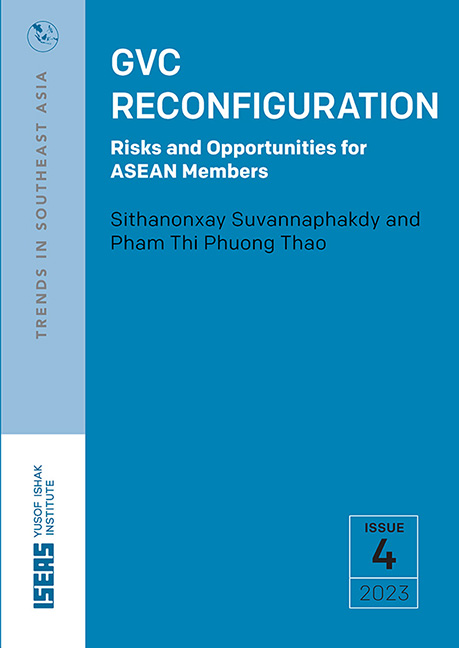
- Publisher:
- ISEAS–Yusof Ishak Institute
- Online publication date:
- January 2024
- Print publication year:
- 2023
- Online ISBN:
- 9789815104127
- Subjects:
- Economics, International Economics
- Series:
- Trends in Southeast Asia

The COVID-19 pandemic, geopolitical tensions and US-China trade disputes, and the Russia-Ukraine war have increased the risk of global value chain (GVC) disruptions and forced firms to strengthen resilience in their supply chains and operations. MNCs have diversified suppliers, established new production sites, and shifted production closer to consumers. ASEAN countries are becoming increasingly attractive destinations for foreign investors. This paper gauges the position of ASEAN in GVCs and assesses the risks and opportunities of GVC reconfiguration for ASEAN countries. ASEAN countries are increasing their participation in GVCs and raising domestic value-added. The relocation of production sites from China to ASEAN countries could enhance their participation in GVCs. Should MNCs increase the concentration of supplier and buyer markets, ASEAN countries could become more vulnerable to external shocks.
The upstream and downstream GVCs in ASEAN countries are dominated by the US, China and Japan. Extraregional trade integration could be enhanced by linking key suppliers and buyers in China, the US, and Japan to producers in ASEAN countries. Trade policy measures to strengthen ASEAN GVCs should focus on a faster release of perishable goods and intermediate inputs at border checkpoints, accelerating the cross-border paperless trade reforms, promoting the utilization of rules of origins under RCEP, streamlining non-tariff measures, and digitalizing ASEAN GVCs.
 Loading metrics...
Loading metrics...
* Views captured on Cambridge Core between #date#. This data will be updated every 24 hours.
Usage data cannot currently be displayed.